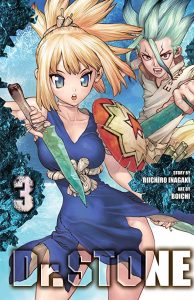Kakuriyo: Bed & Breakfast for Spirits, Volume 3 by Waco Ioka and Laruha
This is one of those series that ends up getting stronger with each volume. I thought the first volume was okish, liked the way the second volume showed more character development, and appreciated the balance between backstory and new plot elements in the third volume. One thing I tend to look for in series about ayakashi is some interesting character design or art that captures my attention. While the art for this series is fine, I wasn’t getting that same sense of wonder about the spirit world that other ayakashi-centric manga titles have delivered. In this volume, I did find the portrayal of wall demons blocking Aoi’s path to be delightful, as they looked like pieces of wallboard dressed in formal kimonos.
Aoi is slowly finding more of a rhythm to her life in the spirit world with the discovery that her food is unique in bolstering the spiritual energy of the demons that surround her. She becomes more involved in the lives of the spider demon siblings, Suzuran and Akatsuki. They tie in to her own story with her grandfather, as she learns that he took them in and temporarily made them his servants when they were fleeing for their lives. Suzuran wants to go back to the human world to exist near Shiro’s grave, and Akatsuki is absolutely opposed to her dream. Aoi mediates this sibling relationship with nourishing food, and the steps in cooking her dishes are more clearly portrayed in this volume. It didn’t quite deliver the level of obsessive detail that I like to see in a food manga, but I appreciated food preparation getting more attention, since it is so central to Aoi’s identity.
One thing I really enjoy about this series now is how each volume tells a satisfying story while inspiring more questions for the reader to ponder. Shiro’s actions and motivations seem more mysterious the more Aoi learns about him. I’m also curious to find out more about Ginji after seeing him report back to the Odanna. I’m enjoying the measured pace at which this story is developing.





Recent Comments